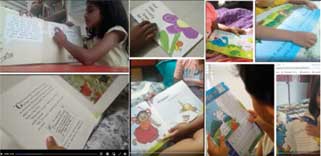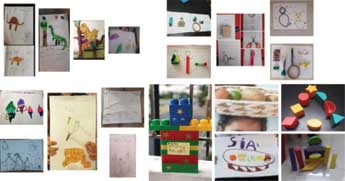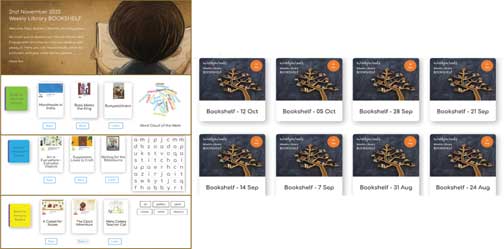Drishti Tyagi
My library practice is a home based neighbourhood concept and I would like to share with you mini reflections of my journey through the Corona days so far, re-discovering my belief in the need for a neighborhood library for the youngest of young readers.
Come Corona and the plans of having a dedicated ‘physical’ space, ‘physical’ interactive sessions, access to ‘physical’ books – all came to a full stop in my little library world. Ironically, one of the reasons I started my home library was to promote reading ‘physical’ books over ‘digital’ apps.
Initially, I had planned for two months of read-aloud sessions with children and engagement through interactive activities. Now, I wondered how to go about providing access to stories and interactions with no in-person events, indoors or outdoors and no lending and return of physical books.
As the children of the neighbourhood had access to Internet, I started to explore ways to bring stories online. I realized that there were quite a few online read-aloud and digital formats available that parents might already be exploring and using. I wondered if this was enough for children or if there was anything I could do that was more personal, more connected with friends and the community.

So, I explored various resources to understand the what and how of online library work. There were seminars, blogs, websites, journals, digital books, publisher provided online norms and resources for professional development that helped quickly skill educators to the whole gamut of online apps and delivery pedagogies.
Online library engagement options
As I researched, I realized my options were:
- Recording a book read-aloud and sharing in my community.
But this will not have any interaction and may duplicate what is already available online. - Conduct an online live time program.
This seemed to have more potential as I would get to see, interact and converse with children. I could use the books we have in the library and when things open up, children could come and pick those books for reading. This would help with continuity in reading and use of library resources. - Support children to continue their reading practice by inviting them to record and share a book read-aloud.
This seemed to have potential too as children would get the opportunity to read and share the books they like.
Having a 6 year old at home, I acutely felt a child’s need to meet, play and interact with friends. The closest way to make this possible was to bring them all together online and so I decided to experiment with two of the above options that would allow children to connect with each other, share their day and promote reading among themselves.
Children reading and posting one video
Each child was encouraged to read aloud, record and share one book every day. We posted and interacted on a closed Facebook (FB) Group with parental consent. We did this for 15 days with 8 to 9 children participating in this activity.
Duration: March 18, 2020 to April 2, 2020
Skills: This activity encouraged children to read aloud and share their reading with others, but they needed parents’ support in recording and uploading.
Apps used: Smartphone to record, Community FB closed group to share videos securely.
Response: Children enjoyed reading the books they had, but lack of continuous flow of books stopped us from doing it for long. The youngest reader was a three-year-old, who posted her reading along with few read-aloud videos of her brother and father reading to her. This was very heartening as the whole family got involved in this program.

Weekly online read-aloud sessions
As children were unable to access books from libraries, I started to do weekly read-aloud sessions for 5-9 year-olds. We had around 5-6 sessions in the one month before the schools started online. I chose books that were easy to understand over the network with unpredictable connectivity, had humor and scope of play through extension activities. To bring in clarity and understanding of the activities, I shared the before and after activity instructions on the FB group so children could do the tasks offline and post the video or their work in their own time.
Duration: April 8, 2020 to May 13, 2020
Skills: Read-aloud best practices, book selection, relevant and easy to execute online friendly activities.
Apps used: Zoom, FB closed group to share session outcome and feedback securely.
Response: The children and I really enjoyed these sessions. We had six sessions that were made rich with enthusiastic participation and interaction of the children and parents. Children came up with creative ways to complete the tasks like making puppets, using blocks and things readily available at home. As children were familiar with each other, this also provided them with a platform to connect in times of isolation. But we had to stop the program as the new school session started for me and later for the children.
With schools starting online, there was little time for online library or book reading activities. I was hesitant to add any more screen time from my side and parents and schools were also cautious on how to use the limited screen time with so much defined curriculum for the children. This led to my experimenting with a digital version of a library collection.
Digital online bookshelf
I wondered if a digital version of a library can be a solution for continuous access to reading material and not necessarily needing a synchronous, dedicated library hour. The only catch was that there will not be any interaction with the library educator and peer readers which I know is critical. I decided to go ahead with this experiment of a digital library based on the underlying belief that if a digital library capsule containing curated stories, audio stories and some interactive play was provided, the parents and educators (primarily English language teachers) could take it forward with children to continue their independent reading and thinking. This was done for three months and stopped after 14 editions as shared in the Response segment below.
Duration: July 27, 2020 – Nov 4, 2020
Skills: Curation of online resources, collation, designing
Apps used: MS PowerPoint, MS Word, PDF, WordPress, Google Forms, Image formatting, Facebook Library Page
Response: There was some interest in the usage of the digital library in the beginning with a few parents and teachers sharing their positive reading experience with children. But as the weeks went by, the initial interest didn’t seem to sustain. The onus of effective usage was on the adults, who had to make the time and effort to use this resource apart from their regular work. This I realized was not the solution I was looking for. It is possible that the result might have been different if I had used this with children in real time as part of a planned online library session. As the effort to curate and design was much higher than its usage, it was stopped. The bookshelf continues to be available here (https://wordywoods.com/weekly-bookshelf/) for any future use.
Learnings as a library educator
By the end of 2020, I arrived at a few key tenets of library practice that I know bring the joy of reading closer to children.
a. Personal interaction of library educator with children whether online or offline. They are the ones really invested in bringing stories alive to children and not just using story as a language building tool.
b. Children need a safe and encouraging space to respond to the story and share with other readers. Reading is not just an activity to be done in isolation but is also a very enriching shared activity with fellow readers. The pleasure and learning are multifold if the story is read and reflected upon in a supported community.
c. Using digital tools only to supplement the core online library program. The various apps and digital modes are just tools and resources to be used by library educators and not a replacement of personally driven library programs.

So, when the second wave came and pushed us back to the online mode in April 2021, I kept in mind my learnings, the request from parents and the need of the children and I restarted the weekly Online Book Reading session with 5-7 and 7-9 year-old children. This time I was more confident of my sessions and felt better able to conduct them more meaningfully.
This past one year made me realize the need and importance of a neighborhood library*, a library that is closer home to a child, a library that a child can walk or cycle to, a library where members and library educators are personally connected. The emotional bond that each child forms with the library educator and members is the key to having an ongoing engagement with reading programs whether online or offline. I feel privileged to be working in this space and to be able to provide a library service to the community and its readers.
*Since the scope of my work was in the neighborhood, I have used this term, but the same may be true for a school library or a community library or a reading club. The key common factor being the library educator and the members share a personal rapport with each other.
| Some helpful resources for adapting to the digital mode 1. E-Books – Storyweaver (free), Getlitt (paid app), Epic (free for educators during pandemic) 2. Interactive Read Aloud sessions – Bookworm Goa (paid), Storytrails (paid) 3. Book Read Aloud – Bookworm Goa YouTube channel (free), StoryLine Online (free), TCLP YouTube channel (free), Read Brightly YouTube channel (free), Storytime from space (free) 4. Podcast – Bookworm Goa (free), Buguri Radio (free) 5. Audio books – Audible (paid), Librivox (free), Lit2go (free) 6. School Library Journal (limited access) 7. The community library network 8. Learning Librarians FB Group 9. The Digital Librarian FB Group 10. Reading Raccoons Children’s Literature FB Group |
The author is a library educator with a zeal for learning and reading. She underwent the 7-month Library Educator’s Course offered by Bookworm Library, Goa and Tata Trust’s Parag Initiative. This opened up the scope and opportunity that a library offers in bringing stories and books in children’s lives on a regular basis. Since 2018 she is running a home-based children’s library in her neighborhood in Bengaluru. She worked briefly in an alternate school as library educator from June 2019 to December 2020. Currently, she is pursuing Diploma in Early Childhood Education from Azim Premji University. She can be reached at drishti@wordywoods.com.
